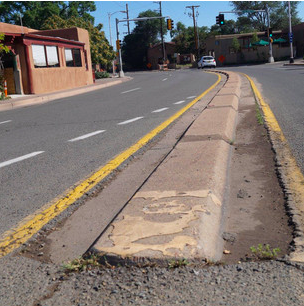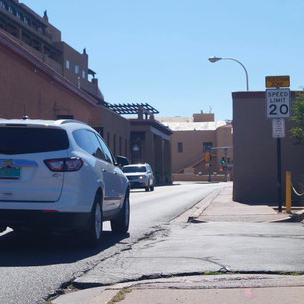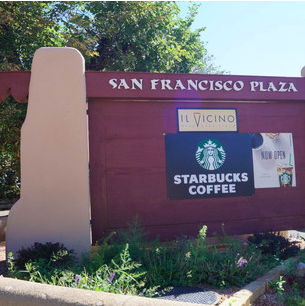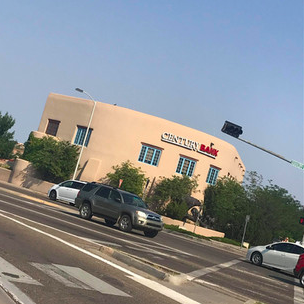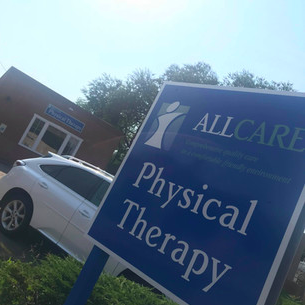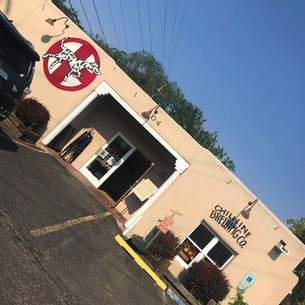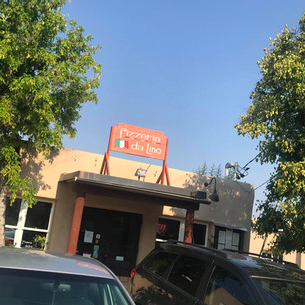Guadalupe Street - Reconstruction Project
Transforming Guadalupe Street
What can improved road design, pedestrian access and safety, enhanced economic development and tourism,
and improved foot-traffic bring to Santa Fe’s historic North Guadalupe Street Corridor?
The North Guadalupe Street Corridor in Santa Fe, New Mexico,
is located in the downtown metro area and the areas that are part of the historic Camino Real,
which has been in use since the 1500’s.
The North Guadalupe Street Corridor will undergo a reconstructive "Road Diet"
to support development of a more "Complete Street."
Why?
to encourage and enhance pedestrian/bicycle use and safety, to accommodate ADA accessibility,
to improve general traffic flow in the specified area, to recognizing historic design considerations,
to maximize economic opportunities for the area and the city of Santa Fe.
What can improved road design, pedestrian access and safety, enhanced economic development and tourism,
and improved foot-traffic bring to Santa Fe’s historic North Guadalupe Street Corridor?
The North Guadalupe Street Corridor in Santa Fe, New Mexico,
is located in the downtown metro area and the areas that are part of the historic Camino Real,
which has been in use since the 1500’s.
The North Guadalupe Street Corridor will undergo a reconstructive "Road Diet"
to support development of a more "Complete Street."
Why?
to encourage and enhance pedestrian/bicycle use and safety, to accommodate ADA accessibility,
to improve general traffic flow in the specified area, to recognizing historic design considerations,
to maximize economic opportunities for the area and the city of Santa Fe.
What is a Complete Street ?
"Complete Streets are streets for everyone.
They are designed and operated to enable safe access for all users,
including pedestrians, bicyclists, motorists and transit riders of all ages and abilities. Complete Streets make it easy to cross the street, walk to shops, and bicycle to work." Smart AmericaMore
Guadalupe Street Reconstruction Project - Facebook Page
According to SmartGrowthAmerica.org:
"Creating Complete Streets means transportation agencies must change their approach to community roads. By adopting a Complete Streets policy, communities direct their transportation planners and engineers to routinely design and operate the entire right of way to enable safe access for all users, regardless of age, ability, or mode of transportation. This means that every transportation project will make the street network better and safer for drivers, transit users, pedestrians, and bicyclists--
making your town a better place to live."
What does a Complete Street look like?
There is no singular design prescription for Complete Streets; each one is unique and responds to its community context. A complete street may include: sidewalks, bike lanes (or wide paved shoulders), special bus lanes, comfortable and accessible public transportation stops, frequent and safe crossing opportunities, median islands, accessible pedestrian signals, curb extensions, narrower travel lanes, roundabouts, and more.
A Complete Street in a rural area will look quite different from a Complete Street in a highly urban area, but both are designed to balance safety and convenience for everyone using the road.
See examples of Complete Streets case studies
What are the benefits of Complete Streets?
Complete Streets help create livable communities for various types of users, including children, people with disabilities, and older adults. Complete Streets improve equity, safety, and public health, while reducing transportation costs and traffic woes. The National Complete Streets Coalition developed a series of fact sheets exploring the many benefits of Complete Streets;
Access the Complete Street fact sheets
Learn
Basics of Complete Streets
Research on Complete Streets
"Complete Streets are streets for everyone.
They are designed and operated to enable safe access for all users,
including pedestrians, bicyclists, motorists and transit riders of all ages and abilities. Complete Streets make it easy to cross the street, walk to shops, and bicycle to work." Smart AmericaMore
Guadalupe Street Reconstruction Project - Facebook Page
According to SmartGrowthAmerica.org:
"Creating Complete Streets means transportation agencies must change their approach to community roads. By adopting a Complete Streets policy, communities direct their transportation planners and engineers to routinely design and operate the entire right of way to enable safe access for all users, regardless of age, ability, or mode of transportation. This means that every transportation project will make the street network better and safer for drivers, transit users, pedestrians, and bicyclists--
making your town a better place to live."
What does a Complete Street look like?
There is no singular design prescription for Complete Streets; each one is unique and responds to its community context. A complete street may include: sidewalks, bike lanes (or wide paved shoulders), special bus lanes, comfortable and accessible public transportation stops, frequent and safe crossing opportunities, median islands, accessible pedestrian signals, curb extensions, narrower travel lanes, roundabouts, and more.
A Complete Street in a rural area will look quite different from a Complete Street in a highly urban area, but both are designed to balance safety and convenience for everyone using the road.
See examples of Complete Streets case studies
What are the benefits of Complete Streets?
Complete Streets help create livable communities for various types of users, including children, people with disabilities, and older adults. Complete Streets improve equity, safety, and public health, while reducing transportation costs and traffic woes. The National Complete Streets Coalition developed a series of fact sheets exploring the many benefits of Complete Streets;
Access the Complete Street fact sheets
Learn
Basics of Complete Streets
Research on Complete Streets
What is a Road Diet ?
According to the US Department of Transportation Federal Highway Adminstration (FWHA): "A classic Road Diet typically involves converting an existing four-lane, undivided roadway segment to a three-lane segment consisting of two through lanes and a center, two-way left-turn lane. A roadway reconfiguration known as a Road Diet offers several high-value improvements at a low cost when applied to traditional four-lane undivided highways. In addition to low cost, the primary benefits of a Road Diet include enhanced safety, mobility and access for all road users and a "complete streets" environment to accommodate a variety of transportation modes. The resulting benefits include a crash reduction of 19 to 47 percent, reduced vehicle speed differential, improved mobility and access by all road users, and integration of the roadway into surrounding uses that results in an enhanced quality of life. A key feature of a Road Diet is that it allows reclaimed space to be allocated for other uses, such as turn lanes, bus lanes, pedestrian refuge islands, bike lanes, sidewalks, bus shelters, parking or landscaping."
Why consider a Road Diet?
"Four-lane undivided highways experience relatively high crash frequencies — especially as traffic volumes and turning movements increase over time — resulting in conflicts between high-speed through traffic, left-turning vehicles and other road users.
FHWA has deemed Road Diets a proven safety countermeasure and promotes them as a safety-focused design alternative to a traditional four-lane, undivided roadway. As more communities desire "complete streets" and more livable spaces, they look to agencies to find opportunities to better integrate pedestrian and bicycle facilities and transit options along their corridors. When a Road Diet is planned in conjunction with reconstruction or simple overlay projects, the safety and operational benefits are achieved essentially for the cost of restriping. A Road Diet is a low-cost solution that addresses safety concerns and benefits all road users — a win-win for quality of life. Road Diets stand the test of time, having been implemented by transportation agencies for more than three decades. One of the first installations of a Road Diet was in 1979 in Billings, Montana. Road Diets increased in popularity in the 1990s. Cities, including Charlotte, Chicago, New York, Palo Alto, San Francisco and Seattle, have also opted for the positive impact Road Diets bring to their communities."
Learn
RFHWA Road Diet Informational Guide
FHWA website - Road Diet Info
According to the US Department of Transportation Federal Highway Adminstration (FWHA): "A classic Road Diet typically involves converting an existing four-lane, undivided roadway segment to a three-lane segment consisting of two through lanes and a center, two-way left-turn lane. A roadway reconfiguration known as a Road Diet offers several high-value improvements at a low cost when applied to traditional four-lane undivided highways. In addition to low cost, the primary benefits of a Road Diet include enhanced safety, mobility and access for all road users and a "complete streets" environment to accommodate a variety of transportation modes. The resulting benefits include a crash reduction of 19 to 47 percent, reduced vehicle speed differential, improved mobility and access by all road users, and integration of the roadway into surrounding uses that results in an enhanced quality of life. A key feature of a Road Diet is that it allows reclaimed space to be allocated for other uses, such as turn lanes, bus lanes, pedestrian refuge islands, bike lanes, sidewalks, bus shelters, parking or landscaping."
Why consider a Road Diet?
"Four-lane undivided highways experience relatively high crash frequencies — especially as traffic volumes and turning movements increase over time — resulting in conflicts between high-speed through traffic, left-turning vehicles and other road users.
FHWA has deemed Road Diets a proven safety countermeasure and promotes them as a safety-focused design alternative to a traditional four-lane, undivided roadway. As more communities desire "complete streets" and more livable spaces, they look to agencies to find opportunities to better integrate pedestrian and bicycle facilities and transit options along their corridors. When a Road Diet is planned in conjunction with reconstruction or simple overlay projects, the safety and operational benefits are achieved essentially for the cost of restriping. A Road Diet is a low-cost solution that addresses safety concerns and benefits all road users — a win-win for quality of life. Road Diets stand the test of time, having been implemented by transportation agencies for more than three decades. One of the first installations of a Road Diet was in 1979 in Billings, Montana. Road Diets increased in popularity in the 1990s. Cities, including Charlotte, Chicago, New York, Palo Alto, San Francisco and Seattle, have also opted for the positive impact Road Diets bring to their communities."
Learn
RFHWA Road Diet Informational Guide
FHWA website - Road Diet Info
About the Project
Goals and Objectives:
improve general traffic flow in the specified area
accommodate ADA accessibility
encourage and enhance pedestrian/bicycle use and safety
recognizing historic design considerations
maximize economic opportunities for the area and the city of Santa Fe.
As noted in the Public Meeting materials shared on March 29, 2018
The purpose of this project is to:
Improve sidewalks and ramps so to provide ADA accessibility
and safely serve pedestrian traffic
Improve corridor safety for all corridor user
Enhance economic development opportunities
Project Design Elements will:
Include access management strategies and techniques;
Enhance street lighting: and
Improve multimodal accommodation (pedestrian and bicycle)
Factors contributing to the need for the project:
High number of driveways and large driveway widths
Narrow 3-ft and 4-ft sidewalk widths in segments of the street corridor
High volume of pedestrian access constraints impacting economic development
Goals and Objectives:
improve general traffic flow in the specified area
accommodate ADA accessibility
encourage and enhance pedestrian/bicycle use and safety
recognizing historic design considerations
maximize economic opportunities for the area and the city of Santa Fe.
As noted in the Public Meeting materials shared on March 29, 2018
The purpose of this project is to:
Improve sidewalks and ramps so to provide ADA accessibility
and safely serve pedestrian traffic
Improve corridor safety for all corridor user
Enhance economic development opportunities
Project Design Elements will:
Include access management strategies and techniques;
Enhance street lighting: and
Improve multimodal accommodation (pedestrian and bicycle)
Factors contributing to the need for the project:
High number of driveways and large driveway widths
Narrow 3-ft and 4-ft sidewalk widths in segments of the street corridor
High volume of pedestrian access constraints impacting economic development
Meet the Team
CommUNTY Learning Network, the City of Santa Fe, and the Santa Fe Community College are working with numerous local organizations, individuals, students, interns, VISTA Summer Associates, and NM Youth Ambassadors to produce a short educational film on the Guadalupe Street Reconstruction Project to create a "Complete Street" by implementing a "Road Diet" in the historic Guadalupe corridor. Youth and local interns are working collaboratively to gather interviews of key players and stakeholders to capture the important aspects of the process and collaboration between all stakeholders. Interviews and a narrative film was developed of meetings, planning sessions, community events, and time-lapse and aerial photography, as well as historical photographic and graphic elements to convey basic facts and history.
CommUNTY Learning Network, the City of Santa Fe, and the Santa Fe Community College are working with numerous local organizations, individuals, students, interns, VISTA Summer Associates, and NM Youth Ambassadors to produce a short educational film on the Guadalupe Street Reconstruction Project to create a "Complete Street" by implementing a "Road Diet" in the historic Guadalupe corridor. Youth and local interns are working collaboratively to gather interviews of key players and stakeholders to capture the important aspects of the process and collaboration between all stakeholders. Interviews and a narrative film was developed of meetings, planning sessions, community events, and time-lapse and aerial photography, as well as historical photographic and graphic elements to convey basic facts and history.
Erick Aune, City of Santa Fe
Kris Swedin and Milton Riess, Santa Fe Community College
Jennifer Nevarez and teams, CommUNITY Learning Network (CLN) and NM TechWorks
Emily Cole - Full Year VISTA, AmeriCorps Vista 2019
Kris Swedin and Milton Riess, Santa Fe Community College
Jennifer Nevarez and teams, CommUNITY Learning Network (CLN) and NM TechWorks
Emily Cole - Full Year VISTA, AmeriCorps Vista 2019
Special Thanks to CommUNITY Learning Network Vistas, Interns, NM Youth Ambassadors including:
JC Ramirez, Alexis Rodriguez, Elizabeth Guthrie
Rebecca Darling, Matt Moschell, Geneva Hancock
Jadeyn Segura, Simon Ballard, Seven Ballard, Nicolas Nevarez
Tierra Encantada Charter School and Turquoise Trail Charter School
Collaborating Organizations, Businesses, Civic Agencies, and Individuals
Monique Anair - Seattle Film Institute
Eric Streeper - Xerb TV
Leonard Pascual A Sound Look
Shawn Blake - Descartes Labs
Jorie Koster-Hale - Falling Colors
Jerry Richardson - President, Historic Guadalupe Home Owner's Association
David Quintana - City of Santa Fe, Roadway and Design
Carlos Cervantes - Local Artist and Community Member
Renee' Villareal - City Councilor
Lynne Gahan - Community Member
Deb Dominguez - Community Member
Peter Olson - Community Member
Liz Perlstein - Community Member
Patti Meccia and Don Meccia - Community Member
JC Ramirez, Alexis Rodriguez, Elizabeth Guthrie
Rebecca Darling, Matt Moschell, Geneva Hancock
Jadeyn Segura, Simon Ballard, Seven Ballard, Nicolas Nevarez
Tierra Encantada Charter School and Turquoise Trail Charter School
Collaborating Organizations, Businesses, Civic Agencies, and Individuals
Monique Anair - Seattle Film Institute
Eric Streeper - Xerb TV
Leonard Pascual A Sound Look
Shawn Blake - Descartes Labs
Jorie Koster-Hale - Falling Colors
Jerry Richardson - President, Historic Guadalupe Home Owner's Association
David Quintana - City of Santa Fe, Roadway and Design
Carlos Cervantes - Local Artist and Community Member
Renee' Villareal - City Councilor
Lynne Gahan - Community Member
Deb Dominguez - Community Member
Peter Olson - Community Member
Liz Perlstein - Community Member
Patti Meccia and Don Meccia - Community Member
|
City of Santa Fe Metropolitan Planning Organization (MPO)
David Quintana [email protected] 505-955-6672 500 Market Street, Suite 200 P.O. Box 909 Santa Fe, NM 87504 City of Santa Fe Transit Keith Wilson [email protected] 505-955-222 3 2931 Rufina St. P.O. Box 909 Santa Fe, NM 87504 City of Santa Fe Planning Noah Berke [email protected] 505-955-6647 200 Lincoln Ave., 1st Floor P.O. Box 909 Santa Fe, NM 87504 City of Santa Fe Planning Nicole Ramirez Thomas naramirez- [email protected] 505-955-6660 200 Lincoln Ave., 1st Floor P.O. Box 909 Santa Fe, NM 87504 |
City of Santa Fe Land Use
Lisa Martinez [email protected] City of Santa Fe Melissa McDonald [email protected] NM DOT Brad Fisher [email protected] 505-827-5396 1120 Cerrillos Road, Santa Fe, NM 87504 NM DOT Stephen Lopez [email protected] 505-995-7700 1120 Cerrillos Road, Santa Fe, NM 87504 Santa Fe Public Schools 601 Alta Vista Street Santa Fe, NM 87505 Friends of Architecture Tom Spray [email protected] 505-428-9056 444 Galisteo Street, Santa Fe, NM 87501 Bicycle Trails Advisory Committee Stephen Newhall |
Guadalupe/Railyard District
Historic Guadalupe Neighborhood Association Jerry Richardson [email protected] 703 Don Felix, Santa Fe,NM 87501 Saint Catherine’s Neighborhood Association Daniel Gibson Downtown-Guadalupe Business District Association West Guadalupe Historic District Neighborhood Association Ellen Herr [email protected] 109 Jimenez Street Santa Fe, NM 87501 West Guadalupe Historic District Neighborhood Association Louise Spenser [email protected] 109 Jimenez Street Santa Fe, NM 87501 Lawrence Leichtman [email protected] 505-467-8637 |
We would not be able to complete this project without the help of our interns and Vista Summer Associates working with CommUNITY Learning Network and the New Mexico TechWorks and the TechHire Santa Fe Working Group thanks to support from the Santa Fe Community Foundation's Opportunity Santa Fe Birth to Career initiative.
|
JC Ramirez
"My name is JC Ramirez, I am a DREAMER from Aguascalientes, Mexico. I have been making an effort to be a part of my community ever since before I graduated from Capital High School in the top 10% of my class. During high school I was able to be introduced to the active members of my community from the Hispanic Chamber of Commerce Members through my life mentor Roy Martinez. Thanks to his efforts in making sure students have the extra help they need in developing their own skills in their own passions, I was interested in helping other students do the same. After high school, I was able to be an AVID tutor for students who were planning on being their family’s first generation to attend college just as I had done going to UNM. To this day, with all my students, I will always do my best to ignite the sense of striving for their goals no matter what they perceive their obstacles might be. With the help of the VISTA program, I will continue to reach more students and meet new people who will want to do the same." "Jennifer is visionary, strategic, effective, creative resourceful, and fun to work with ... and she gets things done!" local member of the regional Tech Task Force and TechHire Working Group.
|
Alexis Rodriguez
"My name is Alexis Rodriguez, I am an ambitious 18 year old college freshman with the mindset of pursuing a technical career. I graduated from Capital High School in May 2018, and decided to get deeper into the technology field. I have always had an interest within technology, whether it is the exterior or interior perspective of it, I tend to enjoy it all. I have some experience in graphic design, photography, website designing (front & back end). Throughout high school, I was enrolled in the design pathway, as well in a film class, and I have found a passion in technology. I believe that I can be very creative when I get an opportunity for something. My Senior Year at Capital, I was the boy’s varsity team captain and it was a great responsibility that I needed to manage. My liability as a leader has been demonstrated as I engage in other people's perspectives and ideas. I ensure that I allow decision-making within my group and so that the most efficient solution is delivered. Therefore, I was never so responsive to the role because I feel that my type of leadership is that of a team effort build up. It was my duty to make sure we communicated as a team, not to communicate for the team. I never ran the team by myself, I accounted many of my teammates to help me through the season. I love to be productive in many aspects, and working with computers is a big one. As I look back into the past, I recognize that I have accomplished many things because of technology. Therefore, I decided to engage into my community through the AmeriCorps Vista Program. I was motivated to try Opportunity Santa Fe because of the people around me. I was inspired by my parents, my teachers, my colleagues and my girlfriend. Therefore, I dived into this program to explore the many career opportunities that Santa Fe has to offer. As a Vista intern I have truly seen and learned a large array of things. All of which have motivated me to become more involved with the community and the various professionals within it. One day I know I will be thanking Americorps for selecting me as an intern and hope to obtain a career." |
Interviews
Local students, interns, and New Mexico Youth Ambassadors are out and about this summer and fall interviewing community members of all ages and gathering reflections from some of the key project stakeholders including staff and representatives from the following:
- ADA Accommodations
- City Planning Department
- City Engineering Department
- State Department of Transportation
- New Mexico Department of Cultural Affairs
- Federal Agencies involved
- Wilson and Company, Project Contractors
- Guadalupe Area Business Owners
- Guadalupe Area Homeowners, HOA’s
- Department of Tourism
- Historic Review Board
- Green and Renewable Infrastructure implementation i.e., water harvesting, green
space and solar electric for signs, lights, etc. - Architects, Landscape Architects and Urban Designers
- City Councilors and Civic representatives
- Community members of all ages
Public Meetings for Guadalupe Street Reconstruction Project
Guadalupe Study Open House Presentation Final
Guadalupe Street RSA Final Report
Guadalupe Street RSA Appendix Part 1
Public Meeting Presentation 03/29/2018
Guadalupe Street Alternatives Booklet
Pedestrian Walk Quality
Guadalupe St Ped Crossings
Intersection Layouts
Public Meeting Presentation 08/09/2018
Intersection Treatments Handout
Comments / Concerns: If you have any additional comment regarding the materials displayed at public meeting or concerns related to the future of this corridor
please click on the following link: Guadalupe Street Comment Form
Guadalupe Study Open House Presentation Final
Guadalupe Street RSA Final Report
Guadalupe Street RSA Appendix Part 1
Public Meeting Presentation 03/29/2018
Guadalupe Street Alternatives Booklet
Pedestrian Walk Quality
Guadalupe St Ped Crossings
Intersection Layouts
Public Meeting Presentation 08/09/2018
Intersection Treatments Handout
Comments / Concerns: If you have any additional comment regarding the materials displayed at public meeting or concerns related to the future of this corridor
please click on the following link: Guadalupe Street Comment Form
Key events with CommUNITY Learning Network:
Guadalupe Street Reconstruction
Guadalupe Business Association and Guadalupe Barrio Project
|
Mar 29, 2018
THURS PUBLIC MEETING - DESIGN OPTIONS REVIEW Public Meeting to review Design Options May 08, 2018 TUES 9:30-11:00 AM PUBLIC MEETING at the CITY of SANTA FE MARKET STREET OFFICES Public Meeting at 500 Market Street May 18, 2018 FRI 2-6PM YOUTH AMBASSADOR MEETING and COMMUNITY FILMING - Guadalupe Street Youth Ambassador Meeting and filming Community Event - Bike to Work Day LOCATION - the new Starbucks at 109 N Guadalupe St, Santa Fe, NM 87501 and the County Offices Jun 05, 2018 10-12 Noon MEET with STUDENT INTERNS Meeting with Student Interns. Jun 08, 2018 FRI 5-7 PM GUADALUPE GRAFFITTI PAINTOUT with NEIGHBORS Paint-out of Guadalupe area graffitti with neighbors Jun 09, 2018 Sat 2-4PM SERVICE LEARNING - Mural Painting We will be gathering with neighbors and students to restore the murals in the pocket Park on Alto Street across from the Boys and Girls Club in the historic Guadalupe Neighborhood District north of the Railyard. All ages and families welcome. Jun 14, 2018 THURS 2-5PM LOCAL BUSINESS SITE VISIT and TEAM PLANNING MEETING Local business site visit and team planning meeting. Jun 19, 2018 TUES 2-6:30 PM LOCAL BUSINESS SITE VISIT Local business site visit - Co-Fe.co, Yoga Source, and Iconik Guadalupe. Jun 20, 2018 WED 4-5:30PM PROTEC / INTERNS GUADALUPE STREET MEETING and INTERVIEWS Intern meeting and interviews at local business Jun 20, 2018 THURS 5:30 PM -9 PM NEIGHBORHOOD MEETING and RESIDENT INTERVIEWS Neighborhood Meeting, Community Outreach, and Resident Interviews. Jun 26, 2018 TUES 1-4PM PLANNING MEETING and FILM WORKSHOP Planning Meeting and Basic Filming Workshop with Santa Fe FilmWorks. Jun 28, 2018 WED 10-12 Noon INTERVIEWS Student and Intern Film Team interview local community members. Jun 28, 2018 THU 9-11AM INTERVIEWS Student and Intern Film Team will interview local professionals working on the project. |
Jul 04, 2018
Wed 8am-1pm COMMUNITY EVENT - Pancakes on the Plaza A super-fun morning facilitating an art activity for community members of all ages at the annual Pancakes on the Plaza event. Youth Ambassadors will greet the public, assist with the RadHatter Art Activity helping everyone decorate hats out of paper bags, and film interviews, too! Jul 06, 2018 9-12 Noon PHOTOGRAPHY with STUDENT INTERNS Guadalupe Neighborhood Meeting and Photography workshop with Student Interns Jul 06, 2018 FRI 12noon INTERVIEW Student and Intern Film Team meet with community members. Jul 11, 2018 WED 11-1pm BUSINESS SITE VISIT and OFFICE MEETING Business Site Visit and Office Meeting A Sound Look Jul 13, 2018 9-12 Noon PHOTOGRAPHY with STUDENT INTERNS Meeting and Photography workshop with Student Interns. Jul 13, 2018 FRI 1-3 PM SERVICE LEARNING - Mural Painting We will be gathering with neighbors and students to restore the murals in the pocket Park on Alto Street across from the Boys and Girls Club in the historic Guadalupe Neighborhood District north of the Railyard. All ages and families welcome. Jul 18, 2018 WED 2:30-3:30PM PLANNING MEETING Planning Meeting at Guadalupe Starbucks with Jennifer and Mary. Aug 09, 2018 THURS 5:30-3:30PM PUBLIC MEETING at the SANTA FE CONVENTION CENTER Public Meeting April 1, 2019 In order to make banners possible along the Guadalupe St. corridor the community will need to raise approximately $5,000.00 to print and install the banners. There are roughly 40 businesses along the south Guadalupe St. corridor. so the suggested contribution is $125 per business. Some businesses will be able to contribute more than the $125 and other's less. The banner project is completely self funded by the Guadalupe St. businesses and we will not be able to proceed until we have 100% of the funds April 15, 2019 The Parish Shrine of our Lady of Guadalupe church gave their approval without any objections for the proposed use of the Guadalupe image on the banners for the Guadalupe Street Association Banner project. May 20, 2019 The Guadalupe St. Banner proposal heard by the City Finance Committee at 5:00 p.m. at City Hall. Initial estimate was $5,000 which includes printing, installation, and a deposit for removal. May 29, 2019 The Guadalupe St. Banner proposal is on the City Council agenda for May 29th at City Hall. Our city partners have stressed that it is vital to get as much attendance at this meeting as possible in order to show the city that we are aligned in our commitment to revitalize and promote Guadalupe St. During the hearing, individuals are given the opportunity to speak for a maximum of 2 minutes. It would be extremely impactful to have as many business owners as possible voice their support in person to the City Council. |













